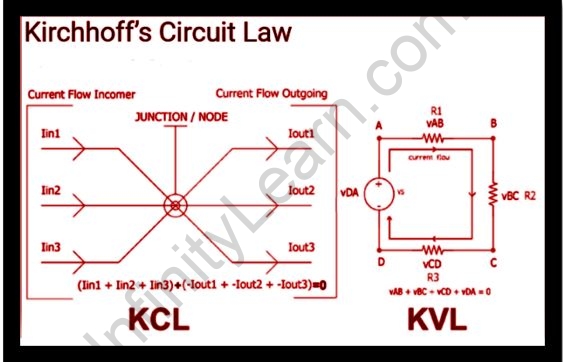Table of Contents
Kirchhoff’s Laws and their Applications: Kirchhoff’s circuit rules constitute two equalities in the lumped model of electrical circuits that are concerned with a current and potential difference. Gustav Kirchhoff, a German scientist, was the first to describe them. This extended Georg Ohm’s work and arrived earlier James Clerk Maxwell’s. Kirchhoff’s rules, often known as Kirchhoff’s laws, are widely utilized in electrical engineering. These laws apply in both time and frequency levels and serve as a basis for network theory. In the low-frequency limit, both of Kirchhoff’s laws can be interpreted as corollaries of Maxwell’s equations. They are accurate for DC circuits and AC circuits at frequencies when electromagnetic radiation wavelengths are very big in comparison to the circuits. In this article, we shall discuss about the Kirchhoff’s Laws and their Applications.
A brief outline
Kirchhoff’s laws describe how current flows in a circuit and how voltage varies around a circuit loop.
- The current coming into a node (or a junction) must equal the current flowing out of it, according to Kirchhoff’s current law (1st Law). Charge conservation has resulted in this.
- Kirchhoff’s voltage law (2nd Law) states that the sum of all voltages across components that supply electric power (such as cells or generators) in any full loop within a circuit must equal the sum of all voltages across all other components in the same loop. This law is the result of both charge conservation and energy conservation.
Join Our Courses: JEE Class 11 Students | JEE Class 12 Students | JEE Dropper
Important concepts
Kirchhoff’s First Law, often known as Kirchhoff’s Current Law, is a set of laws developed by Kirchhoff.
Kirchhoff’s Current Law states that
- Because no charge is lost, the total current entering the junction or a node is equivalent to a single charge leaving the node.
- To put it another way, the algebraic sum of all currents entering and exiting the node must be zero. The conservation of charge property of Kirchhoff law is defined as I(exit) + I(enter) = 0.
- The currents I1, I2, and I3 entering the node are positive in value, whereas the currents I4 and I5 leaving the node are negative in value. This can be stated mathematically as follows:
I1 + I2 + I3 – I4 – I5 = 0
- A junction or connection of two or more current-carrying routes, such as cables and other components, is referred to as a node. Parallel circuits can also be analyzed using Kirchhoff’s current law.
Kirchhoff’s Second Law, sometimes known as Kirchhoff’s Voltage Law, is a law that governs the voltage of a system.
Kirchhoff’s Voltage Law states that
- For any closed network, the voltage surrounding a loop equals the sum of all voltage drops in the same loop, as well as zero.
- To put it differently, the algebraic total of all the voltages in the circuit must equal zero, and this characteristic of Kirchhoff’s law is known as energy conservation.
- When you start at any position in the loop and keep going in the same direction, you’ll see that the voltage declines in all directions, whether negative or positive, and you’ll come back to the same spot. It is critical to maintaining either a counterclockwise or a clockwise rotation; otherwise, the final voltage value will not be zero.
- The voltage law can also be used to analyze series circuits.
- When analyzing either AC or DC circuits using Kirchhoff’s circuit rules, you must be familiar with all of the terminologies and descriptions used to define circuit components such as routers, nodes, meshes, and loops.
Kirchhoff’s Laws and their Applications
- In analogue electronics, Kirchhoff’s rules are frequently utilized to solve complex electrical circuits. Kirchhoff’s principles are used to assess any AC electrical circuit by altering them to account for electromotive forces, resistors, capacitors, and other components.
- However, technically, these guidelines are only relevant for identifying circuits that cannot be reduced by mixing elements in series and parallel.
- Although applying Kirchhoff’s rules to problems concerning complex AC circuits that cannot be simplified by incorporating circuit components in series or parallel is typically much easier, Kirchhoff’s rules are universally applicable that should be used to resolve issues involving complex AC circuits that cannot be eased by combining circuit elements in series or parallel.
Kirchhoff’s laws have the flaw of working under the premise that the closed-loop magnetic field is constant. In the presence of a changing magnetic field, electric fields and emf can be induced, breaking the statement of Kirchhoff’s loop rule. Kirchhoff’s law can be seen in single loop circuits, complicated electrical circuits, and charging circuits.

Kirchhoff’s Current Law Principle
KCL works on the idea of charge conservation, which means that we can’t build or destroy a charge. The node/junction in a circuit neither operates as a source nor sink of charge because of the law of conservation of charge. The charge entering the circuit in a unit time balances the charge draining out in a unit time, according to KCL.
Significance of Kirchhoff’s laws and their Application in the IIT JEE exam
Important chapters in physics, such as heat and thermodynamics, electrostatics, and current electricity, are given a 10% weighting. For the JEE test, the most essential chapter in modern physics is weighted at 13.3 per cent, while the rest of the chapters are weighted at 3.3 per cent and 6.6 percent. This chapter primarily contains questions about determining the equivalent resistance of various resistance arrangements, and two Kirchhoff laws, Kirchhoff’s Junction Rule, and Kirchhoff’s Loop Rule will assist you in doing so.

JEE Foundation Class for 10
JEE Foundation Class for 10 enhances critical thinking and problem-solving skills through engaging activities and advanced learning techniques, ensuring academic excellence.
FAQs
Because no charge is lost, Kirchhoff's Current Law asserts that the total current entering a junction or a node is equivalent to a single exiting the node.
Kirchhoff's voltage law states that for every closed network, the voltage surrounding a loop equals the sum of all voltage drops in the same loop and also equals zero.
Gustav Robert Kirchhoff proposed the Kirchhoff laws. State Kirchhoff's Current Law (Kirchhoff's Current Law)
State the Kirchhoff's voltage law.
Kirchhoff's statutes were drafted by who?
Infinity Learn App
Now you can find answers to all your subject queries & prepare for your Exams on our Free Learning App – Infinity Learn.









